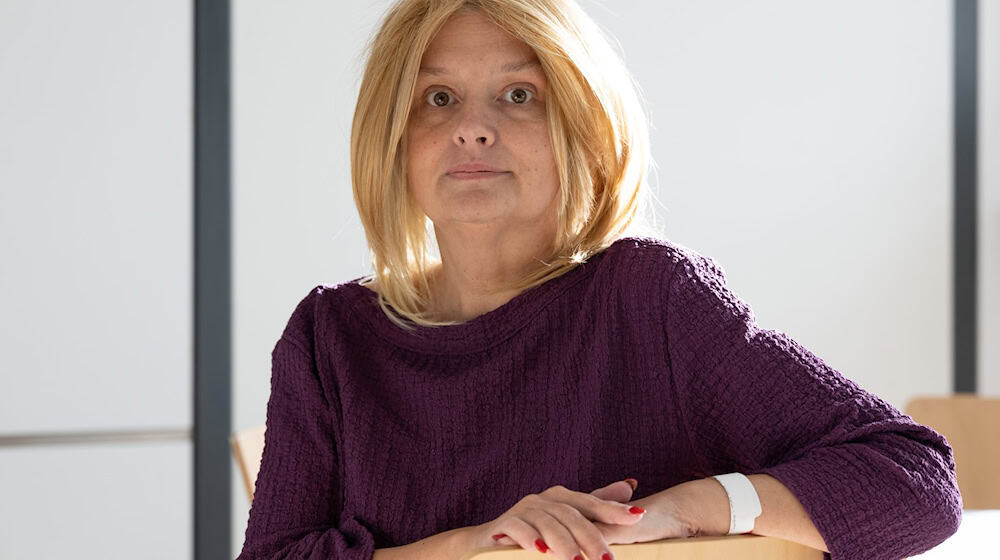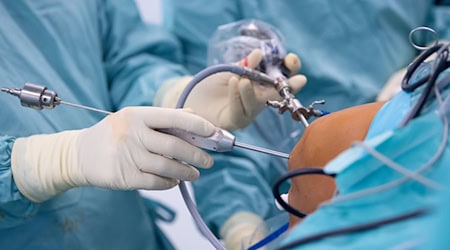Fought off and overjoyed: November 14 must feel like a second birthday for Sabine Treffkorn. On October 20, she had a tumor removed from her pancreas and a metastasis from her liver at the Clinic for Visceral, Thoracic and Vascular Surgery at Dresden University Hospital. Three and a half weeks later, she is now waiting for her discharge certificate under a bright blue sky. She is wearing a purple top. Purple is the color used every year in Germany to commemorate this diabolical cancer. Purple stands for courage and survival.
Hope for the longest possible quality of life
"I'm super happy now because I'm doing really well, amazingly well for such an operation," reveals the 49-year-old project manager from Berlin. "And of course I'm delighted that it worked out and that the doctors and nurses put so much effort into me. I now have great hope that I will have a good quality of life for a long time to come."
Just six months ago, the world looked very different for her. Shortly after Whitsun, she received a diagnosis that in most cases is a death sentence: pancreatic cancer. The disease is particularly insidious, as there are no symptoms in the early stages. Sabine Trefferkorn initially lost more and more weight without changing her lifestyle or diet.
"Then non-specific things came along, such as pain below the ribs. Because they kept disappearing, I didn't go to the doctor," says the woman. Later, it became acute with severe abdominal and back pain. The third time, her mother took her to the emergency room. Initially, the doctors suspected gallstones. However, the diagnosis was soon confirmed.
Diagnosis a shock
"My father died of pancreatic cancer seven years ago. I was already familiar with the disease, but still hadn't thought that I could have it now," says Sabine Treffkorn. She was shocked by the diagnosis. During the examination at Straußberg Hospital, she was told that she could only receive palliative treatment and was shown the palliative care ward.
Even later at Berlin's Charité hospital, she was not given any hope, says Treffkorn. She came to Dresden University Hospital through the mediation of her aunt, a nuclear medicine specialist from Leipzig. She did not experience the period of uncertainty as a rollercoaster ride. "I was actually confident. The fact that they wanted to operate on me in Dresden gave me hope." The support of her family also contributed to this.
Scientists do not yet know exactly why cases of pancreatic cancer have risen sharply in recent years. In Germany alone, there were around 20,000 new cases in 2023. "One reason is certainly that the population is getting older. The older you get, the higher the risk of developing cancer," emphasizes Jürgen Weitz, Director of the Clinic for Visceral, Thoracic and Vascular Surgery at Dresden University Hospital.
In most cases, the disease is just bad luck and coincidence
The professor points to risk factors such as obesity, diabetes mellitus, alcohol consumption, smoking and chronic pancreatitis. There is also a certain hereditary component. "Mostly it's just bad luck and coincidence, unfortunately". If symptoms occur, you shouldn't panic, but you should definitely get yourself checked out.
However, this brings us to the next problem. Because there are no real early symptoms of pancreatic cancer, says Weitz. A classic warning sign is a yellow discoloration of the skin. However, unspecific symptoms such as weight loss, abdominal pain and fatigue can also point to this insidious disease. The same applies to a new onset of diabetes.
Pancreatic cancer fourth most common cause of death from cancer
Pancreatic cancer is currently the fourth most common cause of death from cancer of any gender. By 2030, it will be the second most common, says the 59-year-old professor. There are good screening programs for bowel cancer, prostate cancer and breast cancer. "They are detected at an earlier stage, which improves the prognosis. This is not yet possible with the pancreas."
Pancreatic tumor resection is one of the most difficult procedures in the human body. This is because the organ lies in the middle of the abdomen and is surrounded by important blood vessels. "On the one hand, you have to operate radically and remove the tumor completely. On the other hand, the surrounding area must be spared, and blood vessels may have to be removed if the tumor has grown in there."
"With the pancreas, the doctor is always faced with the decision: Can I remove the tumor or not? It's a question of yes or no. That decides the fate of the patient," says the professor, explaining the problem. Resection is only possible in around 20 percent of patients. For the others, only palliative treatment is possible to alleviate the effects.
Prognosis improves with successful removal of the tumor
Because pancreatic cancer is one of the most aggressive types of cancer and is often detected late, only around eleven percent of patients survive the first five years after diagnosis. "But you have to differentiate. If a tumor is completely removed, the prognosis is much, much better. It is also much better with a combination of resection and chemotherapy."
Although every case of pancreatic cancer is unique, there is a kind of standardized procedure. Before surgery, patients with locally advanced disease receive three months of chemotherapy to shrink the tumor. Chemotherapy often follows the operation. The mortality rate for surgery depends not least on where it is performed. It is said to be lower in a center with experienced specialists.
Pancreatic surgery is considered a very complicated procedure
It is precisely when complications arise during or after the operation that medical skill is required. "Pancreatic surgery is tricky," reports Weitz. It can lead to severe post-operative bleeding. The junction between the pancreas and the intestine is particularly delicate and the experience of the medical team is crucial. With 160 to 180 resections per year, Dresden is one of the largest centers in Germany.
Sebastian Hempel, Sabine Treffkorn's attending senior physician, is one of the doctors in Dresden who has mastered the art of pancreatic surgery. Together with Jürgen Weitz and other colleagues, he spent eight hours removing the tumor from Treffkorn's pancreas. He had a good feeling after the operation.
Positive motivation is the be-all and end-all of treatment
"We have to advise patients well and in detail, explain to them what we can and cannot do with this disease. This can also give them hope and develop positive motivation. This is essential for the overall treatment," says the doctor. The best operation is useless if the patient ultimately lacks the motivation to get out of bed again.
Now that the tumor has been successfully removed, Treffkorn can plan again. She wants to celebrate her 50th birthday on July 20, 2026 in style. The plan has already been decided, but she doesn't want to reveal it - after all, she doesn't want her friends to find out about the surprise from the newspaper.
Patient: "I have hope of starting life again."
Sabine Treffkorn knows that she's not out of the woods yet. "I now have to undergo chemotherapy again, but it's a different feeling. With the first chemo, I didn't know where it was going and whether it would help at all. But now I know it's a conclusion. I have hope to start life again."
She is not alone in this. Every year on the third Thursday in November, buildings in Germany are lit up in purple to draw attention to pancreatic cancer. These are often hospitals. In Dresden, city landmarks such as the Semper Opera House and the Blaues Wunder bridge over the River Elbe have also repeatedly served this purpose. Next Thursday, it will be the Albertinum of the Dresden State Art Collections.
Copyright 2025, dpa (www.dpa.de). All rights reserved










